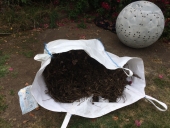








Idle dreamer




The ultimate goal of farming is not the growing of crops, but the cultivation and perfection of human beings. - Masanobu Fukuoka




Seed the Mind, Harvest Ideas.
http://farmwhisperer.com












Idle dreamer
















Lori Evans wrote:I wonder if the sand is to balance mulch acidity?? Either way if I can get that cypress mulch and leave it away from where I plant my seed the ground will retain its moisture well for the year. I'm not sure the reason, but I've read to make sure you don't mix the mulch into the soil, so that may be why it's needed to pull it back when planting. I'll give it a go on my larger beds and see how it works out. Thanks so much!!













Lori Evans wrote:Are these statements in his book? I don't remember them from any of his videos.




Idle dreamer
















Idle dreamer








 1
1





Idle dreamer




Idle dreamer




Tyler Ludens wrote:Not everyone has the luxury of moving to a nice location. Many people need to learn how to garden in less than optimum locations. Seems like permaculture (and permaculturists) could help with that!
I guess if your doing it for fun that is fine.




I have never met a stranger, I have met some strange ones.








Please check me out. http://www.dandeliondreamspermaculture.com
http://www.dandeliondreamsfarm.com








Idle dreamer




Get involved -Take away the standing of corporations MovetoAmmend.org




 1
1




Brenda
Bloom where you are planted.
http://restfultrailsfoodforestgarden.blogspot.com/








Lori Evans wrote:Devon,
What kind of trees are in your wood chips? The mixture here seems to be pine/juniper bushes, locust, birch, cedar, and mulberry. I will be getting these from the city piles where they do all their collections. I hope so many different types will be good for the soil. I got a lot during the winter and placed them under our picnic table area where it was all dirt. There are a lot of big pieces that I could use for stakes, thank you. The only down side of getting my things there is that I have to sift through for some garbage that they have chipped. However, being on such a busy road in a dirty city I am constantly picking garbage out of my front yard anyway.
I did have an issue last night with the birds digging in and eating some of my lettuce and pea seeds. I have to go tonight when I get home from class and get some clay from a dump site. I looked up all my ingredients and such. The seed balls are looking like a must right now with all the birds in our yard. But this is all good experience. This yard is my testing ground for the next several years until we purchase a large amount of land. I might as well just use several different techniques and see what works best. I have several bare (all grass) patches to experiment on.
Thank you all!








Brenda
Bloom where you are planted.
http://restfultrailsfoodforestgarden.blogspot.com/









|
Do not meddle in the affairs of dragons - for you are crunchy and good with ketchup. Crunchy tiny ad:
Learn Permaculture through a little hard work
https://wheaton-labs.com/bootcamp
|




